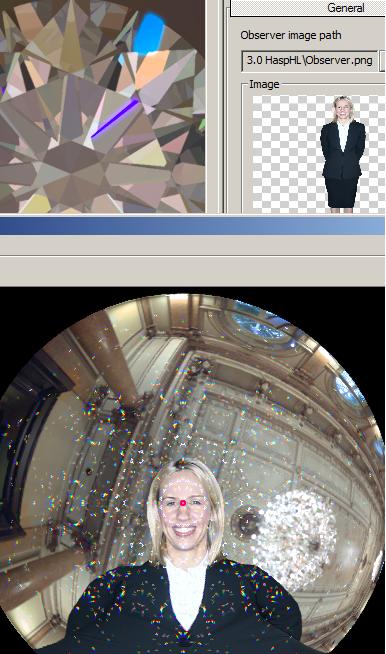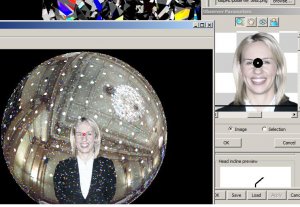stebbo
Shiny_Rock
- Joined
- Jun 8, 2006
- Messages
- 466
Date: 8/9/2007 9:38:28 PM
Author: Garry H (Cut Nut)
Here is a diamonds eye view of one of my staff (programed into DiamCalc as an observer) in a ball room (from a 360 degree high dynamic range HDR) photo. The little specs are the ETAS - they show the places where lights need to be in order to cause a sparkle in the diamond.
Kewl?

I didn't want to hijack another thread, but am interested to know if you've interpreted this correctly. I haven't played with DC3 yet but regardless, I can't make sense of what you say.
This sounds more reasonable to me:
A HDR image file of the room you see roughly depicted above (but minus the ETAS flashes and minus your staff member) was supplied as the lighting environment for the render here. It gets laid on the inside of a hemisphere cupping the diamond (if it is a spherical HDR file) and all the colors and intensities in the image simulate light sources for the computer render. The HDR method of lighting is less accurate but quicker than 3d modeling the whole room and specify lighting, but less accurate than just specifying lighting like in previous DiamCalcs.
The image of your staff members looks to be an additional, user supplied image that gets merged in with the generic HDR file. This allows the user to easily control what the observer looks like and where they are position) without having to create and supply a new HDR file each time (which is a bit of an effort with the typical digital camera).
Finally, the bottom photo is, as you say, how you would see the room if you were sitting inside the diamond, but the ETAS flashes are the resultant light dollops that would appear on the inside of an imaginary black dome cupping the diamond. If a small dome is used, the light is tighter, if a big dome is specified, the colors in the light separate more. Maybe you meant "the ETAS flashes are where an (invisible) observer needs to be to see the intense white or colored light representatively shown here".









300x240.png)